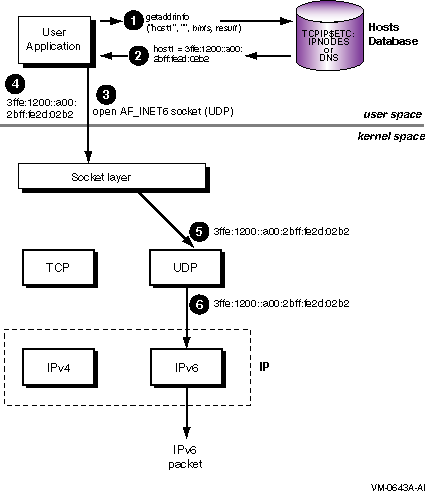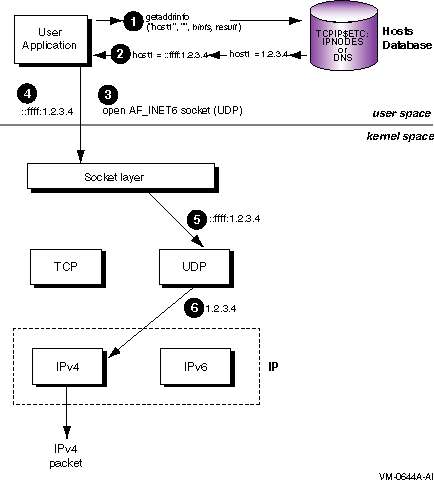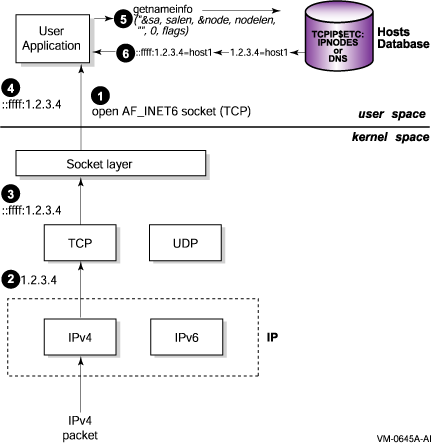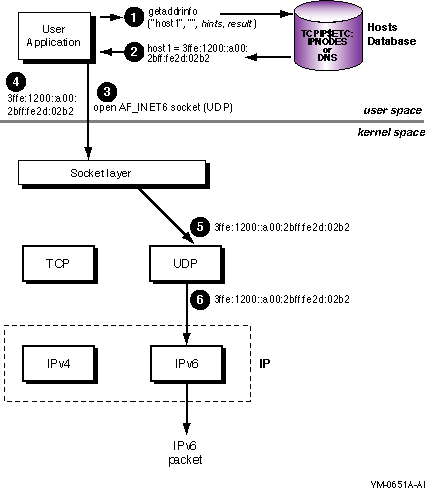| Previous | Contents |
This function has the following syntax:
const char *inet_ntop(
int af,
const void *src,
char *dst,
size_t size);
|
Parameters
Description
The inet_ntop() function converts a numeric Internet address value to a text string.
Return values
Upon successful conversion, the
inet_ntop()
function returns a pointer to the buffer containing the text string. If
the function fails, it returns a pointer to the buffer containing NULL.
6.5.4 Address-Testing Macros
Table 6-3 lists the currently defined address-testing macros and the return value for a valid test. To use these macros, include the following file in your application:
#include <net/in.h> |
| Macro | Return |
|---|---|
| IN6_IS_ADDR_UNSPECIFIED | True, if specified type. |
| IN6_IS_ADDR_LOOPBACK | True, if specified type. |
| IN6_IS_ADDR_MULTICAST | True, if specified type. |
| IN6_IS_ADDR_LINKLOCAL | True, if specified type. |
| IN6_IS_ADDR_SITELOCAL | True, if specified type. |
| IN6_IS_ADDR_V4MAPPED | True, if specified type. |
| IN6_IS_ADDR_V4COMPAT | True, if specified type. |
| IN6_IS_ADDR_MC_NODELOCAL | True, if specified scope. |
| IN6_IS_ADDR_MC_LINKLOCAL | True, if specified scope. |
| IN6_IS_ADDR_MC_SITELOCAL | True, if specified scope. |
| IN6_IS_ADDR_MC_ORGLOCAL | True, if specified scope. |
| IN6_IS_ADDR_MC_GLOBAL | True, if specified scope. |
| IN6_ARE_ADDR_EQUAL | True, if addresses are equal. |
To compile an IPv6 application, you need to set up the following environment:
$ DEFINE DECC$SYSTEM_INCLUDE TCPIP$EXAMPLES: $ DEFINE ARPA TCPIP$EXAMPLES: $ DEFINE NET TCPIP$EXAMPLES: $ DEFINE NETINET TCPIP$EXAMPLES: $ DEFINE SYS TCPIP$EXAMPLES: |
This is a temporary measure and is required until Compaq C has all the IPv6 include files.
The library functions described in this chapter are included in the Compaq TCP/IP Services for OpenVMS Version 5.1 kit.
This chapter describes the changes you must make in your application code to operate in an IPv6 networking environment.
You can also use this information as guidelines for creating new IPv6-ready applications.
See RFC 2553, Basic Socket Interface Extensions for IPv6, for
complete information on the changes to the BSD socket applications
programming interface (API). The basic syntax of socket functions
remains the same. Existing IPv4 applications will continue to operate
as before, and IPv6 applications can interoperate with IPv4
applications.
7.1 Using AF_INET6 Sockets
At present, applications use AF_INET sockets for IPv4 communications. Figure 7-1 shows a sample sequence of events for an application that uses an AF_INET socket to send IPv4 packets.
Figure 7-1 Using AF_INET Socket for IPv4 Communications

Section 7.6.1.1 contains sample program code that demonstrates these steps.
You can use the AF_INET6 socket for both IPv6 and IPv4 communications. For IPv4 communications, create an AF_INET6 socket and pass it a sockaddr_in6 structure that contains an IPv4-mapped IPv6 address (for example, ::ffff:1.2.3.4 ). Figure 7-2 shows the sequence of events for an application that uses an AF_INET6 socket to send IPv4 packets.
Figure 7-2 Using AF_INET6 Socket to Send IPv4 Communications

AF_INET6 sockets can receive messages sent to either IPv4 or IPv6 addresses on the system. An AF_INET6 socket uses the IPv4-mapped IPv6 address format to represent IPv4 addresses. Figure 7-3 shows the sequence of events for an application that uses an AF_INET6 socket to receive IPv4 packets.
Figure 7-3 Using AF_INET6 Socket to Receive IPv4 Communications

For IPv6 communications, create an AF_INET6 socket and pass it a sockaddr_in6 structure that contains an IPv6 address (for example, 3ffe:1200::a00:2bff:fe2d:02b2 ). Figure 7-4 shows the sequence of events for an application that uses an AF_INET6 socket to send IPv6 packets.
Figure 7-4 Using AF_INET6 Socket for IPv6 Communications

Section 7.6.2.1 contains sample program code that demonstrates these steps.
The following sections show how to convert an existing AF_INET
application to an AF_INET6 application that is capable of communicating
over both IPv4 and IPv6.
7.2 Name Changes
Most of the changes required are straightforward and mechanical, though some may require a bit of code restructuring. For example, a routine that returns an int data type holding an IPv4 address may need to be modified to take as an extra parameter a pointer to an in6_addr into which it writes the IPv6 address. Table 7-1 summarizes the changes you must make to your application's code.
| Search file for | Replace with | Comments |
|---|---|---|
| AF_INET | AF_INET6 | Replace with IPv6 address family macro. |
| PF_INET | PF_INET6 | Replace with IPv6 protocol family macro. |
| INADDR_ANY | in6addr_any | Replace with IPv6 global variable. |
The structure names and field names have changed for the following structures:
The following sections discuss these changes.
7.3.1 in_addr Structure
Applications that use the IPv4 in_addr structure must be changed to use the IPv6 in6_addr structure, as follows:
| IPv4 Structure | IPv6 Structure |
|---|---|
|
struct in_addr
unsigned int s_addr |
struct in6_addr
uint8_t s6_addr |
Make the following changes to your application, as needed:
Applications that use the generic socket address structure (sockaddr) to hold an AF_INET socket address ( sockaddr_in ) must be changed to use the AF_INET6 sockaddr_in6 structure, as follows:
| AF_INET Structure | AF_INET6 Structure |
|---|---|
| struct sockaddr | struct sockaddr_in6 |
Make the following change to your application, as needed:
A sockaddr_in6 structure is larger than a sockaddr structure. |
Applications that use the BSD Version 4.4 IPv4 sockaddr_in structure must be changed to use the IPv6 sockaddr_in6 structure, as follows:
| IPv4 Structure | IPv6 Structure |
|---|---|
|
struct sockaddr_in
unsigned char sin_len sa_family_t sin_family in_port_t sin_port struct addr sin_addr |
struct sockaddr_in6
uint8_t sin6_len sa_family_t sin6_family int_port_t sin6_port struct in6_addr sin6_addr |
Make the following changes to your application, as needed:
Applications that use the hostent structure must be changed to use the addrinfo structure, as follows:
| AF_INET Structure | AF_INET6 Structure |
|---|---|
| struct hostent | struct addrinfo |
Make the following change to your application, as needed:
The names and parameters have changed for the following function calls:
The following sections discuss these changes.
7.4.1 gethostbyaddr Function Call
Applications that use the IPv4 gethostbyaddr function call must be changed to use the IPv6 getnameinfo function call, as follows:
| AF_INET Call | AF_INET6 Call |
|---|---|
| gethostbyaddr( xxx,4,AF_INET) | err=getnameinfo( &sockaddr, sockaddr_len, node_name, name_len, service, service_len, flags); |
Make the following change to your application, as needed:
Applications that use the gethostbyname function call must be changed to use the getaddrinfo function call, as folllows:
| AF_INET Call | AF_INET6 Call |
|---|---|
| gethostbyname( name) |
err=getaddrinfo(
node_name,
service_name,
&hints,
&result);
. . . freeaddrinfo( &result); |
Make the following changes to your application, as needed:
Applications that use the inet_ntoa function call must be changed to use the getnameinfo function call, as follows:
| AF_INET Call | AF_INET6 Call |
|---|---|
| inet_ntoa( addr) | err=getnameinfo( &sockaddr, sockaddr_len, node_name, name_len, service, service_len, NI_NUMERICHOST); |
Make the following change to your application, as needed:
Applications that use the inet_addr function call must be changed to use the getaddrinfo function call, as follows:
| AF_INET Call | AF_INET6 Call |
|---|---|
| result=inet_addr( &string) |
err=getaddrinfo(
node_name,
service_name,
&hints,
&result);
. . . freeaddrinfo( &result); |
Make the following change to your application, as needed:
In addition to the name changes, you should review your code for
specific uses of IP address information and variables.
7.5.1 Comparing IP Addresses
If your application compares IP addresses or tests IP addresses for equality, the in6_addr structure changes (see in Section 7.3.1) will change the comparison of int quantities to a comparison of structures. This will break the code and cause compiler errors.
Make either of the following changes to your application, as needed:
| AF_INET Code | AF_INET6 Code |
|---|---|
| (addr1->s_addr == addr2->s_addr) | (memcmp(addr1, addr2, sizeof(struct in6_addr)) == 0) |
| AF_INET Code | AF_INET6 Code |
|---|---|
| (addr1->s_addr == addr2->s_addr) | IN6_ARE_ADDR_EQUAL(addr1, addr2) |
| Previous | Next | Contents |